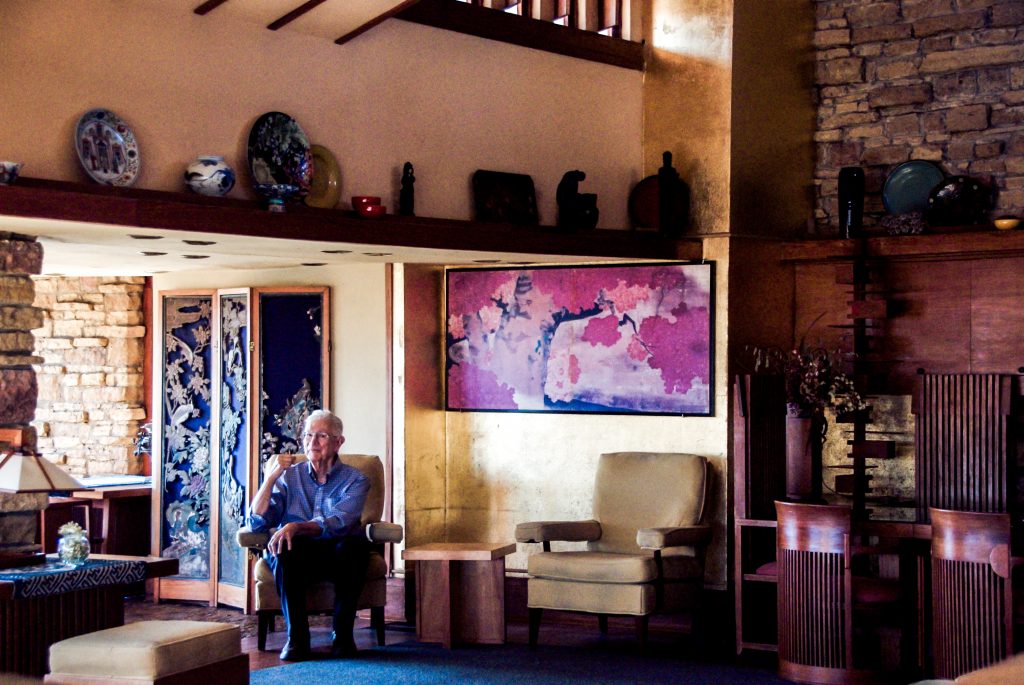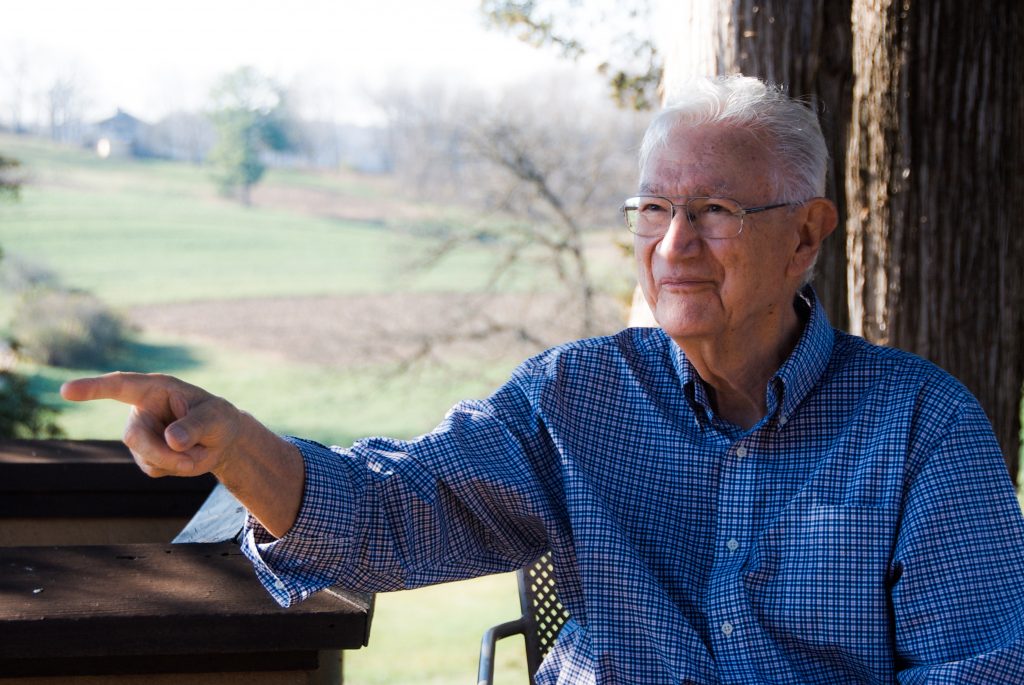It’s 1954, and Tony Puttnam walks into a room that positively pulsates yellow: the cushions resting on the row of Marshall Field’s chairs, the limestone fireplace, the limestone walls. His teenage eyes are flooded by the light pouring in from the dozens of windows. His eyes scan the grand piano, the Japanese print running along a wall, vases of various colors particularly placed, the stone statue of Kuan Yim — the Buddhist goddess of mercy — watching the room from her perch on a half wall.
He can hardly take it all in. But this space is animated, he can feel it.
“This is my place,” he thinks.
It’s the living room of Taliesin, Frank Lloyd Wright’s Wisconsin residence, and the whole thing — structures, sculptures, furniture, flowers — had been purposely arranged and rearranged to perfection by Wright himself.
At 19, Puttnam was an adult when he walked into that room, but it was a youthful impulse that kept him there.
“It was kind of running into a magic show and saying, ‘I want to stay,’” Puttnam says.

He wasn’t the only one instantly drawn in by the drama, struck by the structure of the space. Over the years, he’s heard many people say that walking into that room was like hearing music for the first time. He’s seen architects come in and burst into tears, one declaring, “I’ve never felt such solace.”
“It is always surprising to me to watch people when they first come here — their eyes open, their mouths open,” says Aaron Betsky, dean of the Frank Lloyd Wright School of Architecture at Taliesin. “There’s certainly something about this place and the way that Frank Lloyd Wright transformed it.”
The something has kept Puttnam around for six decades since he arrived. He transformed from student, to teacher, to the architect who would complete the Monona Terrace, Wright’s 1938 design for a “dream civic center” in Madison.
Many people are attracted to the magic of Taliesin, just as Puttnam was. They come in droves every year to snap pictures and sigh in awe. Puttnam instantly fell for the room in a case of love at first site, but it could have been a fling, a fun tourist weekend. Instead, Puttnam’s compatibility and long-term commitment make him a perfect match for Taliesin and the right Wright man to carry on its legacies.
Eighty-two years old now, Puttnam’s foundation is sinking a bit — he’s getting older. If eyes are the windows to the soul, his are just as wonderful as the ones in the living room of Taliesin. They’re not big and showy like those; they’re small and unassuming below a slight salt and peppering of eyebrows. They beam kindness instead of light.
His voice has the universal gruffness that all old men get, and it’s as reassuring as the hum of the dishwasher. It rumbles along as he deliberately, thoughtfully tells me stories from his vast collection as we sit in the Taliesin visitor’s center.

His road to Wright started when he met Wright’s daughter Iovana in Chicago at an event for Armenian mystic George Gurdjieff (Olgivanna, Wright’s third wife, was a big fan of Gurdjieff’s philosophies). Iovana invited Puttnam to see Taliesin. It may have been a casual, flippant invitation — Oh, you should drop by Taliesin sometime — but Puttnam, maybe because he was young, or because he was, in his words, “totally at sea” and not sure what he wanted to do with his life, took her up on it.
When he showed up, he instantly knew he wanted to stick around close to the magic room. And he said so. He was told to wait and take it up with Wright.
“You’d be a little daunted in the White House asking for an interview with the president, but you can get away with a lot at 19,” Puttnam says.
Puttnam waited; Wright returned. They went to Wright’s office and sat down. Then, Wright ran down Puttnam’s deficits, he remembers.
“Can you do carpentry or masonry?”
“No.”
“Have you worked on a building?”
“No.”
“You know, young man, I have to be very careful who I admit here,” Wright told him. “If you put all the mouths in the fellowship together,” he went on, joining his fingertips to form a large O, “You could drive a dump truck through it every day.”
Puttnam was bluffing all the way, Puttnam says, smiling as he remembers, and having a good time with it, too. Wright wasn’t a hard man; but he also wasn’t above making the newcomers sweat a little.
By the end of the interview, Wright simply said, “Well, you’re going to have to duck around here.” The ceilings in Taliesin are low, and Puttnam was over six feet tall.
“And I took that as admission and got out,” Puttnam says.

About a month later, Puttnam got into an accident driving an ancient truck on the property, and had his head wrapped up with a bandage. He ran into Wright, who deadpanned, “Well, I told you to duck.”
Puttnam has deep respect for Wright, but he knows not everybody does.
Wright left his first wife and six children for another woman. He was not one for false humility, once declaring, “Not only do I fully intend to be the greatest architect who has yet lived, but the greatest who will ever live.” Brendan Gill, a biographer and friend of Wright, made casual reference to Wright’s “wildness, his lying, his ruthlessness, his ransacking people.” Puttnam’s had interviewers bluntly ask him, “Why was Frank Lloyd Wright the world’s meanest man?”
But Puttnam’s Wright is quirky and likable — a man who sort of sailed through life with his talent and a lot of confidence. He’s a Wright who didn’t start drawing until he could walk through the building in his head. A Wright who loved movies, even bad ones, and would insist the architects keep watching terrible films and the free reels of propaganda sent by Russian filmmakers. Wright would tell them to wait: the movie might get better. A Wright who drove to a site for a future civic center in California, stepped out of the car for a few minutes, looked at the landscape, and said, “Okay, we can go back now; I know what to do.”
Puttnam sums it up: “Life with Mr. Wright was always unexpected and festive.”
Puttnam certainly has plenty of festive memories of Wright. He tells me another story about a Wright who decided to appear on the Mike Wallace Interview talk show — against the better judgment of everyone, because Wallace’s show was known for his hard-hitting questions. (Wallace would famously reduce Barbra Streisand to tears in an interview years later.) Wallace jumped in by asking Wright’s opinion of organized Christianity, progressed to how Wright felt about being called a “pompous windbag,” and wanted to know how Wright’s attitude toward sex had changed over the last 60 years of his life. Wright waltzed through each question, ending the interview with his musings on immortality. When the cameras stopped rolling, Puttnam says, Wallace quipped, “My name is Mike Wallace; I’m the announcer on the Frank Lloyd Wright Show.”
Wright was unflappable, and so is Puttnam. It’s why Puttnam was the perfect choice to carry out the mission of the Monona Terrace and ultimately fulfill Wright’s architectural prophecy.
Wright’s first proposed a plan for the Madison civic center on the shore of Lake Monona in 1938. But county board votes, World War II, building legislation, over-budget construction bids and referendum dragged out the project until after Wright died in 1959.
When yet another opportunity came up for it to be finished in the 1990s, Puttnam agreed to be the lead architect, despite the controversy that came with it. He was to redesign the interiors, which many committees over the years had muddied with ever-evolving plans, at one point including a roller skating rink.
He explains his willingness partially as an act of gratitude. When Puttnam first arrived at Taliesin, he received a small inheritance from two aunts. He gave half of the money to Wright as tuition. Wright never asked for more.
“Not because I was scholarship material, but he was kind of like that,” Puttnam says. “And so, well, it’s kind of embarrassingly emotional, with the most recent chance of getting Monona Terrace done, I figured I owed it to him. He wanted to see it built.”
“He came back from a very late meeting in Madison, and he was kind of grumpy; and he said, ‘Well, they’re not going to build it now,’ and he put his coat and cane down, and as he left the room he said, ‘But someday they will.’”
They did, and it wasn’t any easier for Puttnam than it had been for Wright. But Puttnam was determined to see it through.
“The Taliesin community had an attitude,” says Peter Rott, co-owner of Isthmus Architecture in Madison, a graduate of the Taliesin School of Architecture and friend of Puttnam. “You would do anything, you’d do what needed to be done, because they all were helping the master’s philosophy continue.”
Rott was a student of Puttnam when he began at the Taliesin School in 1978.
“[As a teacher] oh, he’s — ” Rott laughs. “He has endless patience. He worked with the very new arrivals, the foreign students. Some of the other architects didn’t seem to have time for them, but Tony sometimes did.”
Endless patience turned out to be the number-one qualifying factor for getting the Monona Terrace built.
A particularly feisty group of opponents, Rott remembers, was the biking community of Madison, which was convinced the terrace would spoil their path along Lake Monona. Rott remembers how they would “accidentally” shove their bikes into Puttnam and Rott on the way into public meetings.
Puttnam defused situations and refused to be riled up. The Monona plan had failed many times before when architects had let their egos get in the way, Rott says, and Puttnam wasn’t going to be the lightning rod they were. Puttnam tells me his goal at press conferences was to be boring and unquotable.
“I hate Frank Lloyd Wright buildings!” a man declared at one such press conference a few weeks before construction was set to begin.
Puttnam played psychologist: “Why do you think that is?”
Maybe the man was startled. He probably wasn’t expecting a follow-up question, so he answered truthfully.
“Well, I can’t afford them.”
The crowd laughed.
Rott and Puttnam survived, and the most cursory of glances at the impressive building on the western shores of Lake Monona, with its soft white curves and striking sea of windows, is evidence of their success.
Puttnam still works on the occasional project, and while the terrace may be his most well-known — and the project for which he will receive the most Wright jewels in his crown — Puttnam didn’t come to Taliesin on a mission to complete the terrace. He came to the terrace because of Taliesin. It only took one moment, one look at a living room, to place him on the path that ended with him holding the final keys to a long-foretold Madison convention center.

Back at Taliesin, as we get ready to make our way to the room that started it all, Puttnam gets nervous that when I see it, I’ll miss the magic.
“I’m always afraid of saying too much about the room and people saying, ‘Huh?’” Putnam says.
He’s not the only one who instantly felt the draw of the room, I point out. There must be something about it.
“It’s an interesting —” He pauses and considers. “You’ll see.”
Lisa Speckhard

Lisa is a grad student and the metro reporter at the Capital Times, which sounds pretty cool and Lois Lane-y, if you ask her. Writing long-form is her dream and penning profiles is her passion. Hobbies include under-baking cookies, dancing poorly but enthusiastically and reading murder mysteries. She should really be better at writing these, based on her extensive experience marketing herself for online dating sites. Overall, she manages to be serious about 4 percent of the time.
